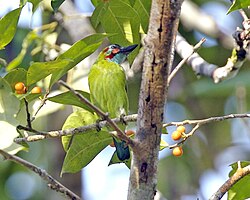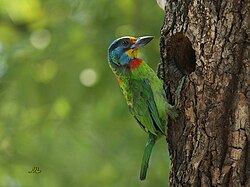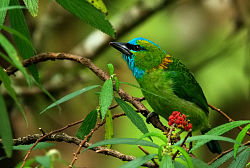| Common name | Scientific name and subspecies | Range | Size and ecology | IUCN status and estimated population |
|---|
| Fire-tufted barbet  | Psilopogon pyrolophus
S. Müller, 1836 | Peninsular Malaysia and Sumatra | Size:
Habitat:
Diet: | LC
|
|---|
| Coppersmith barbet  | Psilopogon haemacephalus
(Statius Müller, 1776 [10] )
- P. h. haemacephalus
- P. h. indicus
- P. h. roseus
- P. h. intermedia
- P. h. delicus
- P. h. mindanensis
- P. h. celestinoi
- P. h. cebuensis
- P. h. homochroa
| Pakistan to the Philippines and Indonesia | Size:
Habitat:
Diet: | LC
|
|---|
| White-cheeked barbet  | Psilopogon viridis
(Boddaert, 1783 [11] ) | Western Ghats and adjoining hills
 | Size:
Habitat:
Diet: | LC
|
|---|
| Great barbet  | Psilopogon virens
(Boddaert, 1783 [12] )
- P. v. virens
- P. v. marshallorum
- P. v. magnificus
- P. v. clamator
| northern India, Nepal and Bhutan, Bangladesh and some parts of Southeast Asia, as far east as Laos | Size:
Habitat:
Diet: | LC
|
|---|
| Brown-headed barbet  | Psilopogon zeylanicus
(Gmelin, 1788)
| Western Ghats and hilly parts of southern peninsular India | Size:
Habitat:
Diet: | LC
|
|---|
| Crimson-fronted barbet  | Psilopogon rubricapillus
Gmelin, 1788 | Sri Lanka | Size:
Habitat:
Diet: | LC
|
|---|
| Blue-throated barbet  | Psilopogon asiaticus
(Latham, 1790) | Indian subcontinent and Southeast Asia | Size:
Habitat:
Diet: | LC
|
|---|
| Lineated barbet  | Psilopogon lineatus
(Vieillot, 1816) | West Bengal and Bangladesh | Size:
Habitat:
Diet: | LC
|
|---|
| Yellow-fronted barbet  | Psilopogon flavifrons
(Cuvier, 1816) | Sri Lanka | Size:
Habitat:
Diet: | LC
|
|---|
| Black-banded barbet  | Psilopogon javensis
(Horsfield, 1821) | Java and Bali | Size:
Habitat:
Diet: | LC
|
|---|
| Yellow-eared barbet  | Psilopogon australis
(Horsfield, 1821) | Java and Bali | Size:
Habitat:
Diet: | LC
|
|---|
| Flame-fronted barbet  | Psilopogon armillaris
(Temminck, 1821) | Java and Bali | Size:
Habitat:
Diet: | LC
|
|---|
| Golden-whiskered barbet  | Psilopogon chrysopogon
(Temminck, 1824)
- P. c. chrysopogon
- P. c. chrysopsis
- P. c. laetus
| Brunei, Indonesia, Malaysia, Thailand, Borneo and Sumatra | Size:
Habitat:
Diet: | LC
|
|---|
| Red-throated barbet  | Psilopogon mystacophanos
(Temminck, 1824) | Myanmar, Thailand, Malaysia, Singapore, Indonesia, Brunei | Size:
Habitat:
Diet: | NT
|
|---|
| Black-eared barbet  | Psilopogon duvaucelii
(Lesson, 1830)
- P. d. duvaucelii
- P. d. gigantorhinus
- P. d. tanamassae
| Peninsular Malaysia, Sumatra and Borneo | Size:
Habitat:
Diet: | LC
|
|---|
| Green-eared barbet  | Psilopogon faiostrictus
(Temminck, 1831) | southern China, Cambodia, Laos, Thailand and Vietnam | Size:
Habitat:
Diet: | LC
|
|---|
| Brown-throated barbet  | Psilopogon corvinus
(Temminck, 1831) | western Java | Size:
Habitat:
Diet: | LC
|
|---|
| Yellow-crowned barbet  | Psilopogon henricii
(Temminck, 1831) | Brunei, Indonesia, Malaysia, Singapore, and Thailand | Size:
Habitat:
Diet: | NT
|
|---|
| Black-browed barbet  | Psilopogon oorti
(Müller, 1836) | Sumatra and the Malay Peninsula | Size:
Habitat:
Diet: | LC
|
|---|
| Red-crowned barbet  | Psilopogon rafflesii
(Lesson, 1839) | Brunei, Indonesia, Malaysia, Myanmar, Singapore, and Thailand | Size:
Habitat:
Diet: | NT
|
|---|
| Golden-throated barbet  | Psilopogon franklinii
(Edward Blyth, 1842 [13] )
- P. f. franklinii
- P. f. ramsayi
| Nepal, India, Bhutan, Myanmar, Thailand, Malaysia, Laos, Vietnam and mainland China | Size:
Habitat:
Diet: | LC
|
|---|
| Blue-eared barbet  | Psilopogon cyanotis
(Blyth, 1847)
- P. c. cyanotis
- P. c. orientalis
- P. c. stuarti (Robinson & Kloss, 1919)
| northeast India and Bangladesh to peninsular Thailand | Size:
Habitat:
Diet: | LC
|
|---|
| Malabar barbet  | Psilopogon malabaricus
(Blyth, 1847) | Western Ghats from around Goa south to southern Kerala
 | Size:
Habitat:
Diet: | LC
|
|---|
| Taiwan barbet  | Psilopogon nuchalis
(Gould, 1863) | Taiwan | Size:
Habitat:
Diet: | LC
|
|---|
| Red-vented barbet  | Psilopogon lagrandieri
(Verreaux, 1868) | Cambodia, Laos and Vietnam | Size:
Habitat:
Diet: | LC
|
|---|
| Chinese barbet  | Psilopogon faber
(R. Swinhoe, 1870) | southern China | Size:
Habitat:
Diet: | LC
|
|---|
| Moustached barbet  | Psilopogon incognitus
(Hume, 1874) | Myanmar, Thailand, Cambodia, Laos and Vietnam | Size:
Habitat:
Diet: | LC
|
|---|
| Golden-naped barbet  | Psilopogon pulcherrimus
(Sharpe, 1888) | Indonesia and Malaysia | Size:
Habitat:
Diet: | LC
|
|---|
| Mountain barbet
| Psilopogon monticola
(Sharpe, 1889) | Borneo | Size:
Habitat:
Diet: | LC
|
|---|
| Bornean barbet  | Psilopogon eximius
(Sharpe, 1892) | Indonesia and Malaysia, Borneo | Size:
Habitat:
Diet: | LC
|
|---|
| Necklaced barbet  | Psilopogon auricularis
(Robinson & Kloss, 1919) | southern Laos and Vietnam | Size:
Habitat:
Diet: | LC
|
|---|
| Indochinese barbet  | Psilopogon annamensis
(Robinson & Kloss, 1919) | Laos, Vietnam and Cambodia | Size:
Habitat:
Diet: | LC
|
|---|
| Turquoise-throated barbet  | Psilopogon chersonesus
(Chasen & Kloss, 1927) | Thailand | Size:
Habitat:
Diet: | LC
|
|---|








































